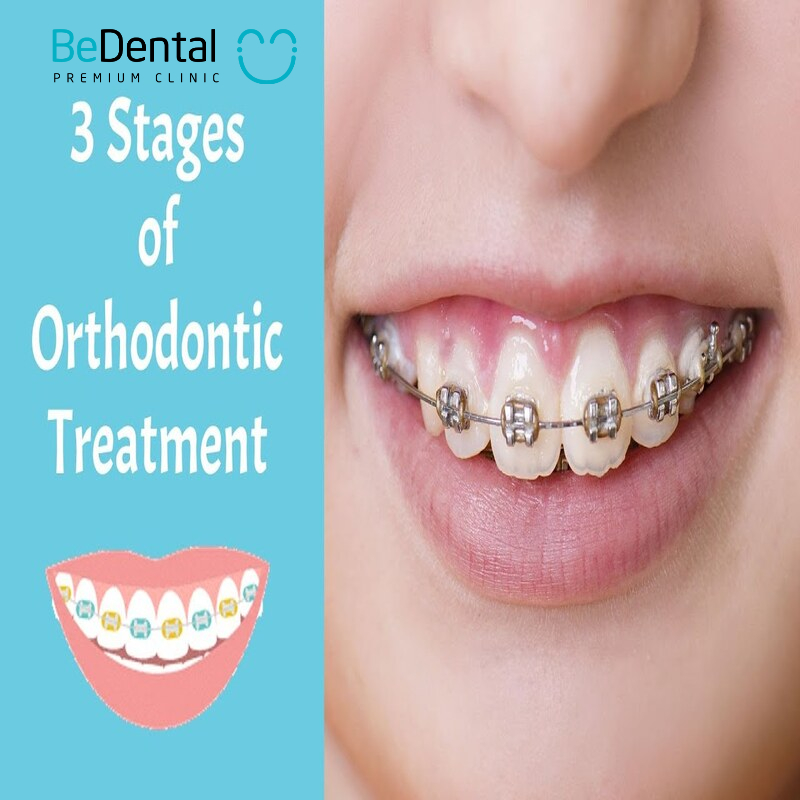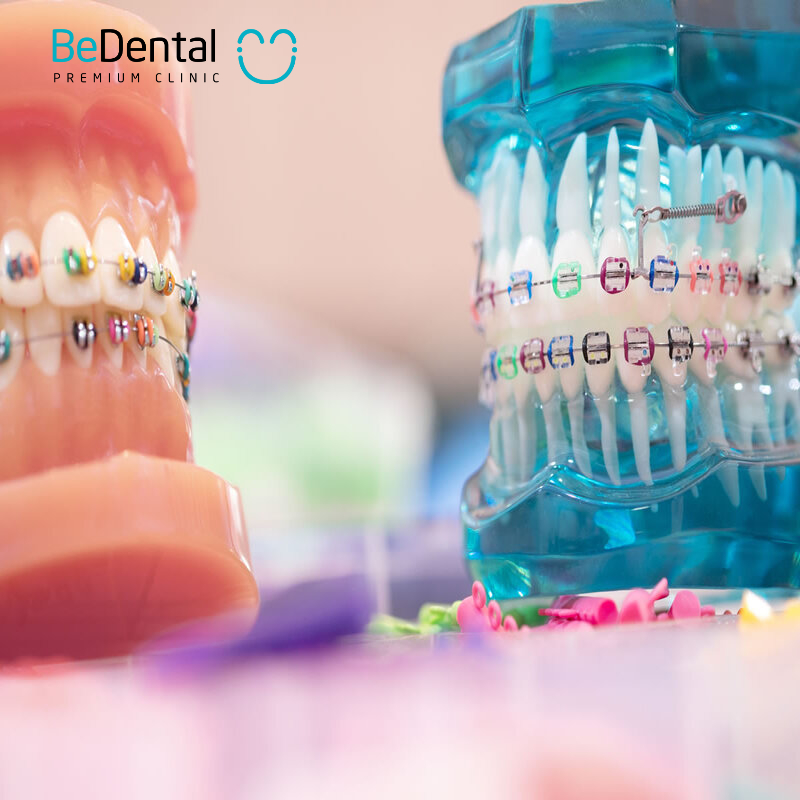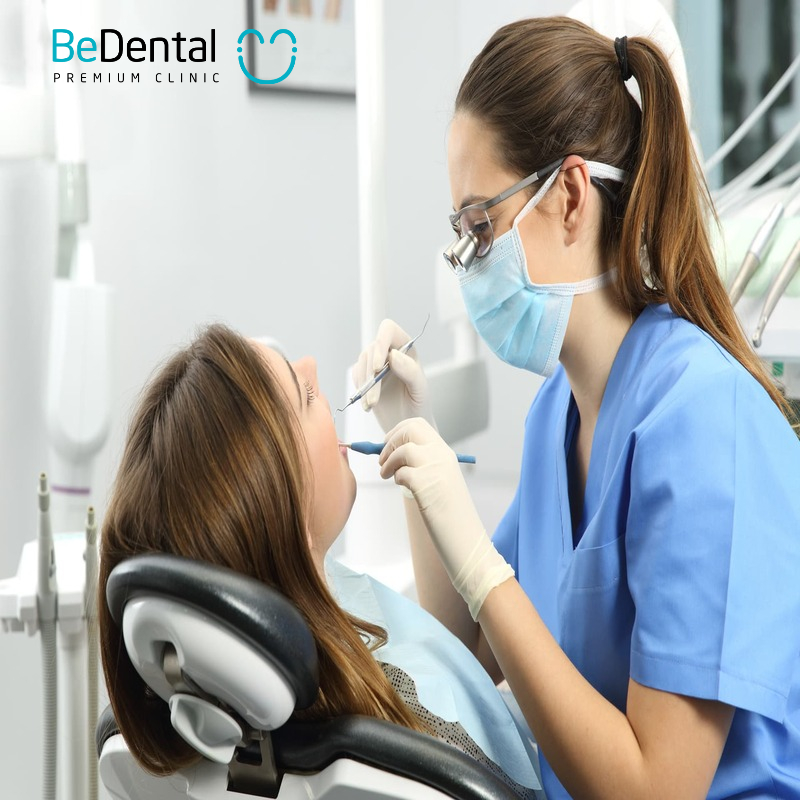Orthodontics has become one of the most popular methods for enhancing smiles and improving oral health. According to a study by the American Dental Association (ADA), approximately 4 million people in the U.S. are undergoing orthodontic treatment, with about 25% being adults. The orthodontic process not only addresses bite issues and misalignment of teeth but also has a positive impact on overall health.
Step 1: Initial Examination and Consultation- The Orthodontic process
The orthodontic process begins with an initial examination and consultation, which is a crucial stage for the doctor to understand the patient’s oral condition. First, the doctor will perform a comprehensive assessment of the mouth, checking for tooth misalignment, bite issues, and other problems. Following this, X-rays and dental impressions will be taken to accurately determine the position of the teeth, jaw structure, and degree of misalignment. Based on these results, the doctor will recommend the most suitable orthodontic methods, estimate treatment duration, and provide specific cost details to help the patient prepare. This foundational step is essential for creating an effective treatment plan.

- Overall Oral Assessment (from TandFonline): The doctor conducts a general examination of the oral condition.
- X-ray Imaging and Impressions: X-ray images and dental impressions help determine tooth positions and formulate a treatment plan.
- Consultation and Treatment Planning: The doctor proposes suitable orthodontic methods, treatment duration, and costs.
Sample Orthodontic Consultation Report:
- Patient Name: Nguyễn Văn A
- Consultation Date: 10/10/2024
- Proposed Orthodontic Method: Metal braces
- Reasons for Method Selection:
- High effectiveness in correcting rotated teeth and bite issues.
- Estimated Treatment Duration: 18 months.
- Cost: 40 million VND.
- Advantages: Fast results, reasonable costs.
- Disadvantages: Braces are visible and may cause initial discomfort.
Treatment Plan:
- Stage 1 (First 3 Months): Correcting rotated teeth and aligning them evenly.
- Stage 2 (Months 3-12): Adjusting the bite and jaw structure.
- Stage 3 (Months 12-18): Finalizing and maintaining the new positions.
Recommendations:
- Treat gum inflammation before proceeding.
- Schedule regular check-ups every 4-6 weeks to adjust wires.
Step 2: Applying Brackets or Aligners
After the examination and consultation, patients will proceed to step 2, which is applying the brackets.
Preparing the Teeth
- Oral Hygiene: Before attaching the brackets, the doctor will thoroughly clean the tooth surfaces to remove plaque and bacteria. This ensures that the brackets or aligners are securely attached without compromising oral health.
- Surface Treatment: The doctor will use a special adhesive to enhance bonding between the brackets and the tooth surface.

Attaching Brackets or Aligners
Brackets: Each bracket will be placed on the teeth using a special dental adhesive and secured with a light to harden the adhesive. For self-ligating brackets, a sliding mechanism will be integrated into the brackets to reduce friction during tooth movement.
Issuing Aligners (Invisalign): If the patient chooses the Invisalign method, the doctor will provide custom-made clear aligners based on the patient’s dental impressions. Each set of aligners will be changed every 1-2 weeks to gradually shift the teeth into position.
Adjusting Wires and Sliding Mechanisms (if applicable)
- Wires: After the brackets are attached, wires will be threaded through the brackets and secured. These wires apply consistent pressure to slowly move the teeth into the correct positions. For self-ligating brackets, the sliding mechanism will automatically adjust the wires to reduce friction and enhance patient comfort during the adjustment process.
- Regular Adjustments: Throughout the orthodontic process, the doctor will periodically check and adjust the pulling force by replacing wires or adjusting the aligners to ensure that treatment progresses as planned.
Step 3: Regular Check-Ups
During each check-up, the doctor will evaluate the movement of the teeth through imaging, the patient’s feedback, and other measurement indicators. This ensures that the teeth are moving according to the original treatment plan. The doctor will assess the effectiveness of the brackets or aligners and decide whether to adjust the pulling force if necessary.
Check-Up Frequency: Check-up intervals typically range from 4-6 weeks, depending on the orthodontic method and the individual patient’s tooth movement speed. In cases using clear aligners (Invisalign), check-up intervals may be more flexible, usually every 6-8 weeks for new aligners. For metal or ceramic brackets, shorter intervals are preferable so the doctor can better manage the adjustment process.
Addressing Issues: During the orthodontic process, issues such as discomfort, tooth misalignment, or unexpected tooth movement may arise. The doctor will adjust the wires, brackets, or change the aligners to address these problems. If patients experience discomfort or have difficulties with eating or speaking, the doctor will provide guidance on temporary solutions and schedule an earlier follow-up if necessary.
Regular check-ups are crucial for the doctor to adjust the orthodontic process, ensuring effectiveness and avoiding unwanted complications.
Step 4: Treatment Conclusion and Bracket Removal
Once the teeth have shifted to the desired positions and the bite has been adjusted, the doctor will proceed with removing the brackets or completing the use of clear aligners. The removal process is typically quick, with the doctor using specialized tools to take off the brackets without damaging the teeth. For Invisalign, the doctor will instruct the patient on how to stop using the aligners.

Final Result Assessment (From Pear Deck Learning): After removing the braces, the doctor will check the bite to ensure that the teeth are stable and aligned. X-ray imaging and clinical examinations will be conducted to evaluate the condition of the teeth, ensuring that the treatment outcomes are optimal. The doctor will also check the facial symmetry and smile and determine if any further adjustments are needed.
Maintaining Results Post-Treatment: Patients will be instructed to wear retainers after removing braces to keep the teeth stable in their new positions. Retainers can be fixed (attached to the back of the teeth) or removable (worn at night), depending on each patient’s dental condition. This helps prevent the teeth from shifting back to their original positions.
This phase is crucial for ensuring that the treatment results are maintained over the long term, achieving both aesthetic and optimal oral health.
Step 5: Maintaining Results After Orthodontics
After braces removal, using retainers is essential to prevent teeth from shifting back to their original positions. There are two common types of retainers: fixed retainers (attached behind the teeth) and removable retainers (worn at night). The doctor will prescribe the type of retainer suitable for the patient’s dental condition, and the retainer should be worn for at least several months or longer, depending on the stability of the teeth.
Post-Brace Oral Care: Proper oral hygiene after braces removal is crucial for preserving treatment results. Patients should use toothbrushes, dental floss, and mouthwash to keep their teeth and gums clean. Additionally, patients need to monitor their diets, avoiding hard or sticky foods that could damage their teeth and retainers.
Maintaining results after orthodontics is vital for ensuring that the treatment achievements are preserved over time and not affected by external factors.
Conclusion
The orthodontic process is an important journey toward improving oral health and enhancing facial aesthetics. From the initial examination and consultation to applying brackets and maintaining results, each step plays a vital role in ensuring treatment effectiveness. Statistics show that orthodontics not only addresses bite issues but also boosts patients’ confidence and quality of life.
To achieve optimal results, adhering to the treatment process and maintaining results is crucial. Patients need to schedule regular follow-ups and practice good oral hygiene to protect their post-orthodontic achievements. Thus, orthodontics is not just a treatment method but an investment in long-term health and a lasting smile. With advancements in dental technology, more effective and aesthetically pleasing orthodontic options are being developed, providing patients with various choices tailored to their individual needs and desires.
BeDental is an experienced clinic specializing in orthodontics in Vietnam
BeDental is an experienced clinic specializing in orthodontics in Vietnam with many years of expertise in braces. The clinic is renowned for its personalized treatment plans tailored to meet the unique needs of each patient, ensuring effective and comfortable results. With a team of qualified orthodontists, BeDental utilizes advanced technology and techniques to provide high-quality orthodontic care. The clinic focuses on achieving optimal alignment and improving dental aesthetics, making it a trusted choice for braces in Vietnam.
For those seeking further consultation regarding dental examination services, please visit BeDental’s locations in Hanoi or Ho Chi Minh City. You can also reach us at our hotline: (+84) 934.61.9090 / (+84) 899.555.636 or through our Facebook page, BeDental, for prompt and accurate assistance.




